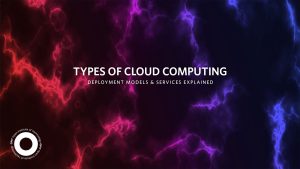

Gone are the days when you had to store boxes of documents in your office. Salvation came in the form of cloud computing in the 2000s. Since then, it’s made a world of difference for businesses across all industries, increasing productivity, organization, and decluttering the workspace. More importantly, it allows businesses to reduce various expenses by 30%-50%.
Cloud computing has countless benefits, but that doesn’t mean the technology is flawless. On the contrary, you should be aware of several disadvantages of cloud computing that can cause many problems with your implementation. Weighing up the pros and cons is essential – and we’ll do precisely that in this article.
Read on for the advantages and disadvantages of cloud computing.
Advantages of Cloud Computing
The cloud computing market is worth more than $540 billion. The main reason being that over 90% of all companies use some form of this technology. Here’s why they rely on cloud-based platforms.
Cost Efficiency
One of the greatest benefits of cloud computing is that it’s cost-efficient and allows you to reduce business expenses on three fronts.
Reduced Hardware and Software Expenses
You don’t need physical hardware to store your documents if you have a cloud computing platform. Likewise, the technology eliminates the need to run multiple software platforms because you can keep all your files in one place.
Lower Energy Consumption
In-house storage solutions can be convenient, but they consume a lot of electricity. Conversely, cloud computing systems help companies increase energy efficiency by over 90%.
Minimal Maintenance Costs
Maintaining such platforms is straightforward and affordable as cloud computing doesn’t involve heavy-duty software and hardware.
Scalability and Flexibility
Another reason cloud computing is popular is its scalability and flexibility. Here’s what underpins these advantages of cloud computing.
Easy Resource Allocation and Management
You don’t need to allocate your storage resources to numerous solutions if you have a unified cloud computing system. Managing your storage requirements becomes much easier with all your money going into one channel.
Pay-As-You-Go Pricing Model
Cloud-based platforms are available on a pay-as-you-go model. This reduces the risk of overpaying for your service because you’re only charged for the amount of data used.
Rapid Deployment of Applications and Services
Deploying cloud computing applications and services is simple. There’s no need for intense employee training, which further reduces your costs.
Accessibility and Mobility
Cloud computing is a highly accessible and mobile technology that can elevate your efficiency in a number of ways.
Access to Data and Applications From Anywhere
All it takes to access a cloud-based platform is a stable internet connection. As a result, you can retrieve key files virtually anywhere.
Improved Collaboration and Productivity
The ability to access data and applications from anywhere boosts collaboration and productivity. Your team gets a unified platform where they can share data with others much faster.
Support for Remote Work and Distributed Teams
Setting up a remote workspace is seamless with a cloud-computing solution. Employees no longer have to come to the office to perform repetitive tasks since they can do them from their computers.
Enhanced Security
If you want to address the most common security concerns in your organization, cloud computing is an excellent option.
Centralized Data Storage and Protection
By storing your information in a centralized location, you decrease the risk of data theft. In essence, you funnel all your resources into one platform rather than spread them out across multiple channels.
Regular Security Updates and Patches
Cloud computing providers offer regular updates to protect your information. Systems with the latest security patches are less prone to cyber attacks.
Advanced Encryption and Authentication Methods
You can also benefit from cloud computing tools due to their next-level encryption and authentication solutions. Most platforms feature AES 256-bit encryption, which is the most advanced and practically impregnable method. Furthermore, two-factor authentication lowers the chances of unauthorized access.
Disaster Recovery and Business Continuity
Business continuity and disaster recovery are two of the most pressing business challenges. Cloud computing solutions can help address these problems.
Automated Data Backup and Recovery
Many cloud storage systems are designed to automatically backup and recover your data. Hence, you don’t need to worry about losing your information in the event of a power outage.
Reduced Downtime and Data Loss
Since cloud computing helps prevent data loss, this technology also saves you less downtime. You don’t have to retrieve information manually because the platform does the work for you.
Simplified Disaster Recovery Planning
Although cloud computing tools are reliable, they’re not immune to failure caused by power loss, natural disasters, and other factors. Fortunately, these platforms have robust disaster recovery plans to get your system up and running in no time.
Disadvantages of Cloud Computing
Since the technology is so effective, you might be asking yourself: “Are there any disadvantages of cloud computing?” There are, and you need to understand these downsides to determine the best way to implement the technology. Here are the main drawbacks of cloud computing.
Data Privacy and Security Concerns
Like any other online technology, cloud computing can put users at risk of data privacy and security concerns.
Potential for Data Breaches and Unauthorized Access
While cloud apps have exceptional security practices, cyber criminals can bypass them with state-of-the-art technology and innovative hacking methods. Consequently, they may gain access to your information and steal your credentials.
Compliance With Data Protection Regulations
Your cloud computing tool may comply with many data protection regulations, but this doesn’t mean your information is 100% secure. Some standards only require apps to use robust password practices and fail to consider other attack methods, such as phishing.
Trusting Third-Party Providers With Sensitive Information
Online services require you to share your information to enable all features. Cloud computing is no different in this respect. You need to provide a third-party vendor with your data, which can be risky.
Limited Control and Customization
Cloud computing is a flexible and scalable technology. At the same time, it limits your control and customization options, which is why you might not be 100% happy with your platform.
Dependence on Cloud Service Providers
You decide what files you wish to share with your cloud-based solution. However, that’s pretty much it when it comes to the control you have over the platform. You depend on the vendor for every other aspect, including updates and patches.
Restrictions on Software and Hardware Customization
There aren’t many options to choose from when selecting a cloud storage plan. The price of your plan mostly depends on how much data you wish to share. Other than that, you get little-to-no hardware and software customization features.
Potential for Vendor Lock-In
Once you create an account with one cloud computing provider, you might not be happy with their services. As a result, you want to switch to a different platform. Many people think this is a simple transition, but that’s not always the case. Even though you can cancel your plan, migrating your data from one tool to the next can be difficult.
Network Dependency and Connectivity Issues
You might be relieved once you set up an account on a cloud-based platform: “I no longer need to clutter my office with masses of documents because I can now use an internet tool.” That said, using an online app also means you depend on network quality.
Reliance on Stable Internet Connection
A stable internet connection is essential for cloud computing. Internet problems can reduce or prevent you from accessing your files altogether.
Performance Issues Due to Network Latency
If your cloud network has high latency, sharing files can be challenging. In turn, latency reduces productivity and collaboration.
Vulnerability to Distributed Denial-of-Service (DDoS) Attacks
Cloud platforms are susceptible to so-called DDoS attacks. A cyber criminal can target your tool and keep you from accessing the service.
Downtime and Service Reliability
Not every cloud computing system performs the same in terms of reducing downtime and maximizing reliability.
Risk of Outages and Service Disruptions
While cloud-based solutions have exceptional recovery plans and backup methods, you’ll still face some downtime in case of outages. Even the shortest service disruption can cause major issues when working on certain projects.
Shared Resources and Potential for Performance Degradation
Cloud systems are convenient because they allow you to store your data in one place. Nonetheless, one of the key disadvantages of cloud computing is managing those shared resources. Accessing information can become difficult if you don’t stay on top of it.
Likewise, performance can drop at any point of your plan. App incompatibility and other issues can compromise data architecture and further compromise management.
Dependence on Provider’s Service Level Agreements (SLAs)
You’ll probably need to enter into an SLA when partnering with a cloud computing provider. These contracts can be rigid, meaning they may fail to recognize and adapt to evolving business needs.
Make an Informed Decision
Cloud computing has tremendous benefits, like improved data storage, collaboration, and cost reduction. The main drawbacks include hardware and software restrictions, connectivity issues, and potential downtime.
Therefore, you should understand the advantages and disadvantages of cloud computing before implementing a platform. Also, consider your business needs when partnering with a cloud provider to help prevent compatibility issues.
Related posts

Bring talented tech experts together, set them a challenge, and give them a deadline. Then, let them loose and watch the magic happen. That, in a nutshell, is what hackathons are all about. They’re proven to be among the most productive tech events when it comes to solving problems and accelerating innovation.
What Is a Hackathon?
Put simply, a hackathon is a short-term event – often lasting just a couple of days, or sometimes even only a matter of hours – where tech experts come together to solve a specific problem or come up with ideas based on a central theme or topic. As an example, teams might be tasked with discovering a new way to use AI in marketing or to create an app aimed at improving student life.
The term combines the words “hack” and “marathon,” due to how participants (hackers or programmers) are encouraged to work around-the-clock to create a prototype, proof-of-concept, or new solution. It’s similar to how marathon runners are encouraged to keep running, putting their skills and endurance to the test in a race to the finish line.
The Benefits of Hackathons
Hackathons provide value both for the companies that organize them and the people who take part. Companies can use them to quickly discover new ideas or overcome challenges, for example, while participants can enjoy testing their skills, innovating, networking, and working either alone or as part of a larger team.
Benefits for Companies and Sponsors
Many of the world’s biggest brands have come to rely on hackathons as ways to drive innovation and uncover new products, services, and opportunities. Meta, for example, the brand behind Facebook, has organized dozens of hackathons, some of which have led to the development of well-known Facebook features, like the “Like” button. Here’s how hackathons help companies:
- Accelerate Innovation: In fast-moving fields like technology, companies can’t always afford to spend months or years working on new products or features. They need to be able to solve problems quickly, and hackathons create the necessary conditions to deliver rapid success.
- Employee Development: Leading companies like Meta have started to use annual hackathons as a way to not only test their workforce’s skills but to give employees opportunities to push themselves and broaden their skill sets.
- Internal Networking: Hackathons also double up as networking events. They give employees from different teams, departments, or branches the chance to work with and learn from one another. This, in turn, can promote or reinforce team-oriented work cultures.
- Talent Spotting: Talents sometimes go unnoticed, but hackathons give your workforce’s hidden gems a chance to shine. They’re terrific opportunities to see who your best problem solvers and most creative thinkers at.
- Improving Reputation: Organizing regular hackathons helps set companies apart from their competitors, demonstrating their commitment to innovation and their willingness to embrace new ideas. If you want your brand to seem more forward-thinking and innovative, embracing hackathons is a great way to go about it.
Benefits for Participants
The hackers, developers, students, engineers, and other people who take part in hackathons arguably enjoy even bigger and better benefits than the businesses behind them. These events are often invaluable when it comes to upskilling, networking, and growing, both personally and professionally. Here are some of the main benefits for participants, explained:
- Learning and Improvement: Hackathons are golden opportunities for participants to gain knowledge and skills. They essentially force people to work together, sharing ideas, contributing to the collective, and pushing their own boundaries in pursuit of a common goal.
- Networking: While some hackathons are purely internal, others bring together different teams or groups of people from different schools, businesses, and places around the world. This can be wonderful for forming connections with like-minded individuals.
- Sense of Pride: Everyone feels a sense of pride after accomplishing a project or achieving a goal, but this often comes at the end of weeks or months of effort. With hackathons, participants can enjoy that same satisfying feeling after just a few hours or a couple of days of hard work.
- Testing Oneself: A hackathon is an amazing chance to put one’s skills to the test and see what one is truly capable of when given a set goal to aim for and a deadline to meet. Many participants are surprised to see how well they respond to these conditions.
- Boosting Skills: Hackathons provide the necessary conditions to hone and improve a range of core soft skills, such as teamwork, communication, problem-solving, organization, and punctuality. By the end, participants often emerge with more confidence in their abilities.
Hackathons at OPIT
The Open Institute of Technology (OPIT) understands the unique value of hackathons and has played its part in sponsoring these kinds of events in the past. OPIT was one of the sponsors behind ESCPHackathon 6, for example, which involved 120 students given AI-related tasks, with mentorship and guidance from senior professionals and developers from established brands along the way.
Marco Fediuc, one of the participants, summed up the mood in his comments:
“The hackathon was a truly rewarding experience. I had the pleasure of meeting OPIT classmates and staff and getting to know them better, the chance to collaborate with brilliant minds, and the opportunity to take part in an exciting and fun event.
“Participating turned out to be very useful because I had the chance to work in a fast-paced, competitive environment, and it taught me what it means to stay calm and perform under pressure… To prospective Computer Science students, should a similar opportunity arise, I can clearly say: Don’t underestimate yourselves!”
The new year will also see the arrival of OPIT Hackathon 2026, giving more students the chance to test their skills, broaden their networks, and enjoy the one-of-a-kind experiences that these events never fail to deliver. This event is scheduled to be held February 13-15, 2026, and is open to all OPIT Bachelor’s and Master’s students, along with recent graduates. Interested parties have until February 1 to register.

The Open Institute of Technology (OPIT) recently held its first-ever career fair to showcase its wide array of career education options and services. Representatives from numerous high-profile international companies were in attendance, and students enjoyed unprecedented opportunities to connect with business leaders, expand their professional networks, and pave the way for success in their future careers.
Here’s a look back at the event and how it ties into OPIT’s diverse scope of career services.
Introducing OPIT
For those who aren’t yet familiar, OPIT is an EU-accredited Higher Education Institution, offering online degrees in technological fields such as computer science, data science, artificial intelligence, cybersecurity, and digital business. Aimed at making high-level tech education accessible to all, OPIT has assembled a stellar team of tutors and experts to train the tech leaders of tomorrow.
The First OPIT Career Fair
OPIT’s first career fair was held on November 19 and 20. And as with OPIT’s lectures, it was an exclusively online event, which ensured that every attendee had equal access to key lectures and information. Interested potential students from all over the world were able to enjoy the same great experience, demonstrating a core principle that OPIT has championed from the very start – the principles of accessibility and the power of virtual learning.
More than a dozen leading international companies took part in the event, with the full guest list including representatives from:
- Deloitte
- Dylog Hitech
- EDIST Engineering Srl
- Tinexta Cyber
- Datapizza
- RWS Group
- WE GRELE FRANCE
- Avatar Investments
- Planet Farms
- Coolshop
- Hoist Finance Italia
- Gruppo Buffetti S.p.A
- Nesperia Group
- Fusion AI Labs
- Intesi Group
- Reply
- Mindsight Ventures
This was a fascinating mix of established enterprises and emerging players. Deloitte, for example, is one of the largest professional services networks in the world in terms of both revenue and number of employees. Mindsight Ventures, meanwhile, is a newer but rapidly emerging name in the fields of AI and business intelligence.
The Response
The first OPIT career fair was a success, with many students in attendance expressing their joy at being able to connect with such a strong lineup of prospective employers.
OPIT Founder and Director Riccardo Ocleppo had this to say:
“I often say internally that our connection with companies – through masterclasses, thesis and capstone projects, and career opportunities – is the ‘cherry on the cake’ of the OPIT experience!
“It’s also a core part of our mission: making higher education more practical, more connected, and more aligned with what happens in the real world.
“Our first Career Fair says a lot about our commitment to building an end-to-end learning and professional growth experience for our community of students.
“Thank you to the Student and Career Services team, and to Stefania Tabi for making this possible.”
Representatives from some of the companies that attended also shared positive impressions of the event. A representative from Nesperia Group, for example, said:
“Nesperia Group would like to thank OPIT for the warm welcome we received during the OPIT Career Day. We were pleased to be part of the event because we met many talented young professionals. Their curiosity and their professional attitude really impressed us, and it’s clear that OPIT is doing an excellent job supporting their growth. We really believe that events like these are important because they can create a strong connection between companies and future professionals.”
The Future
Given the enormous success of the first OPIT career fair, it’s highly likely that students will be able to enjoy more events like this in the years to come. OPIT is clearly committed to making the most of its strong business connections and remarkable network to provide opportunities for growth, development, and employment, bringing students and businesses together.
Future events will continue to allow students to connect with some of the biggest businesses in the world, along with emerging names in the most exciting and innovative tech fields. This should allow OPIT graduates to enter the working world with strong networks and firm connections already established. That, in turn, should make it easier for them to access and enjoy a wealth of beneficial professional opportunities.
Given that OPIT also has partnerships in place with numerous other leading organizations, like Hype, AWS, and Accenture, the number and variety of the companies potentially making appearances at career fairs in the future should no doubt increase dramatically.
Other Career Services at OPIT
The career fair is just one of many ways in which OPIT leverages its company connections and offers professional opportunities and career support to its students. Other key career services include:
- Career Coaching: Students are able to schedule one-on-one sessions with their own mentors and career advisors. They can receive feedback on their resumes, practice and improve their interview skills, or work on clear action plans that align with their exact professional goals.
- Resource Hub: The OPIT Resource Hub is jam-packed with helpful guides and other resources to help students plan out and take smart steps in their professional endeavors. With detailed insights and practical tips, it can help tech graduates get off to the best possible start.
- Career Events: The career fair is only one of several planned career-related events organized by OPIT. Other events are planned to give students the chance to learn from and engage with industry experts and leading tech firms, with workshops, career skills days, and more.
- Internships: OPIT continues to support students after graduation, offering internship opportunities with leading tech firms around the world. These internships are invaluable for gaining experience and forging connections, setting graduates up for future success.
- Peer Mentoring: OPIT also offers a peer mentoring program in which existing students can team up with OPIT alumni to enjoy the benefits of their experience and unique insights.
These services – combined with the recent career day – clearly demonstrate OPIT’s commitment to not merely educating the tech leaders of the future, but also to supporting their personal and professional development beyond the field of education, making it easier for them to enter the working world with strong connections and unrivaled opportunities.
Have questions?
Visit our FAQ page or get in touch with us!
Write us at +39 335 576 0263
Get in touch at hello@opit.com
Talk to one of our Study Advisors
We are international
We can speak in:


